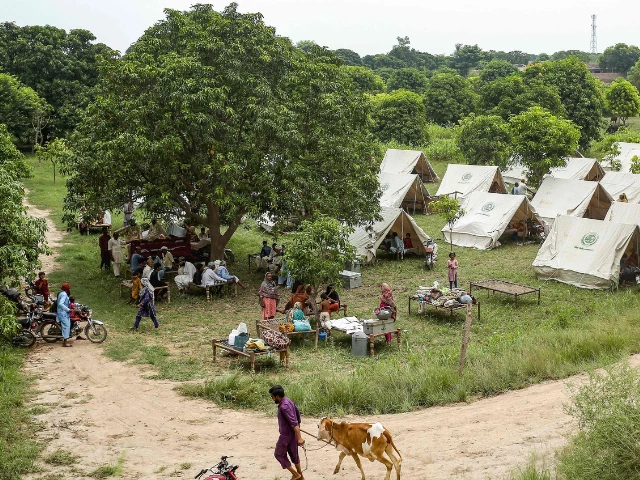LAHORE:
Torrential monsoon rains and surging rivers have unleashed widespread flooding across Pakistan, leaving 881 people dead, over 1,000 injured and around a million displaced, according to the National Disaster Management Authority (NDMA).
“The crisis deepened after India released large volumes of water into the Sutlej without formal notification,” officials said. The move triggered high alerts in at least nine Punjab districts, including Kasur, Okara, Bahawalnagar, Pakpattan, Vehari, Lodhran, Bahawalpur, Multan and Muzaffargarh. Authorities fear additional inflows could worsen situation already described as ‘extremely high flood’ at several points.
The NDMA reported 881 fatalities and 1,176 injuries nationwide in flood-related incidents. Khyber-Pakhtunkhwa (K-P) has borne the heaviest toll with 488 deaths followed by Punjab with 223 fatalities, Sindh 58, Balochistan 26, Gilgit-Baltistan 41, Azad Kashmir 37, and Islamabad reported eight deaths. Among the victims are 510 men, 134 women, and 237 children.
Read: Multan braces for high flood waves from Chenab, Ravi
The floods have destroyed more than 8,200 homes and killed at least 6,180 livestock, compounding economic losses for families already struggling with rising cost of living.
Officials estimate that more than 2.4 million people have been directly affected, while 900,000 have been displaced while large number of settlements and acres of farmland have vanished.
Floodwaters from the Chenab, Ravi and Sutlej have inundated vast areas of Punjab. At Head Trimmu, inflows exceeded 516,000 cusecs, while the Sutlej at Ganda Singh Wala was flowing at 253,000 cusecs. Officials say the volumes could surge further in case of more rains or additional water is released.
In southern Punjab, the Chenab’s surge has entered Multan district, where local authorities are weighing breaching embankments to protect the city.
Former Prime Minister and Senate Chairman Yousaf Raza Gilani said the next 48 hours would be critical, urging residents to cooperate with the rescue teams in their evacuation efforts.
Floodwaters have already submerged more than 200 villages in Jhang, disrupted traffic on key highways and washed away sections of the Grand Trunk (GT) Road linking Lahore, Faisalabad and Multan. In Chiniot, at least 141 villages have been affected, leaving more than 200,000 people struggling to find shelter.
Also Read: EU extends Rs350 million emergency aid for flood victims
In Lodhran, a breach in the Sidiwala embankment forced the evacuation of hundreds of people and livestock as fields and homes went under water. Local officials said rescue teams had shifted more than 600 residents to higher ground.
The death toll continues to rise. In Jhang, a 45-year-old woman drowned while attempting to return to her home when water appeared to recede. Relatives said her body was recovered after about 24 hours.
In Sindh, low-level flooding has been reported at Sukkur, Kotri and Guddu barrages, though many residents in ‘katcha areas’ are resisting evacuation orders. Officials warn that the refusal to leave could complicate relief efforts if river levels continue to rise.
The disaster is also raising health concerns. The national polio eradication programme cautioned that stagnant floodwaters could cause spread of polio and other infectious diseases in vulnerable districts. Schools in several inundated areas have been closed indefinitely, further disrupting daily life.
The Flood Forecasting Division reported that Tarbela Dam has reached full capacity, while Mangla is 83 per cent filled. Rawal Dam has opened its spillways as levels approached the danger mark. Authorities said more rainfall is expected through Sept. 3, with forecasts pointing to continued high flows in the Ravi, Sutlej and Chenab rivers.
Read: Afghan earthquake death toll crosses 1,400,hampers rescue efforts
Emergency operation centres are on alert round-the-clock as rescue teams struggle to reach marooned families. Punjab’s Relief Commissioner has warned that further rainfall in upper catchment areas could intensify flooding through Sept. 5.
For now, tens of thousands remain stranded, farmers watch helplessly as crops are swallowed by floodwaters, and displaced families seek refuge in makeshift camps. The coming days are expected to see rising river levels and the threat of new surges looms.

